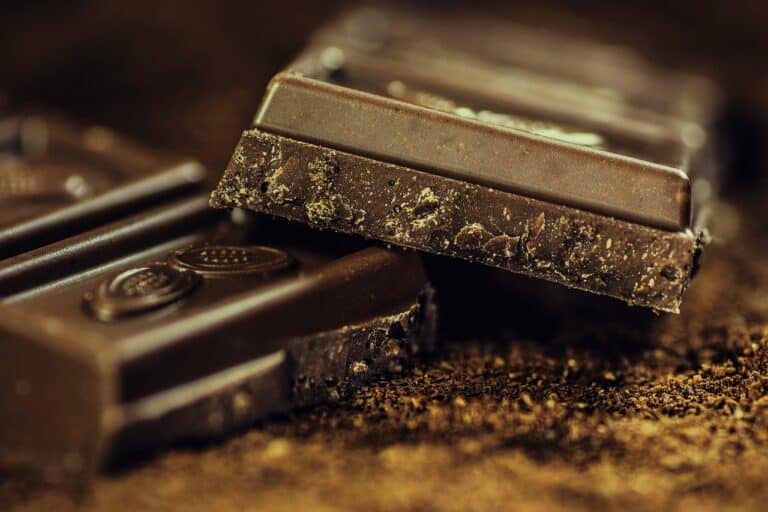Chocolate has delighted taste buds for centuries, and it’s no wonder why. There are countless fun facts about chocolate that can make you appreciate this sweet treat even more. So let’s dive into the world of chocolate and explore its history, the different types of chocolate, and some surprising facts that you may not know!
Cocoa beans are the foundation of all types of chocolate, including dark chocolate, milk chocolate, and white chocolate. These beans are harvested from cacao trees primarily found in West Africa’s Ivory Coast and parts of South and Central America. It’s important to note that cacao beans and cocoa beans are essentially the same thing, with the latter having undergone the roasting process. In order to create chocolate, these beans are transformed into a thick paste called chocolate liquor, which is then separated into solid cocoa solids and liquid cocoa butter.
Dark chocolate is primarily made from the combination of chocolate liquor and cocoa butter, with minimal added sugar. Its distinguishing quality is a high proportion of cocoa solids, giving it a more intense and less sweet taste. On the other hand, milk chocolate is characterized by the addition of milk powder and sugar, resulting in a lighter, sweeter taste. White chocolate does not contain cocoa solids, but it’s mainly composed of cocoa butter, sugar, and milk solids. As for other delicious variations, think of the popular hot chocolate and chocolate chip cookies!
The Rich History of Chocolate
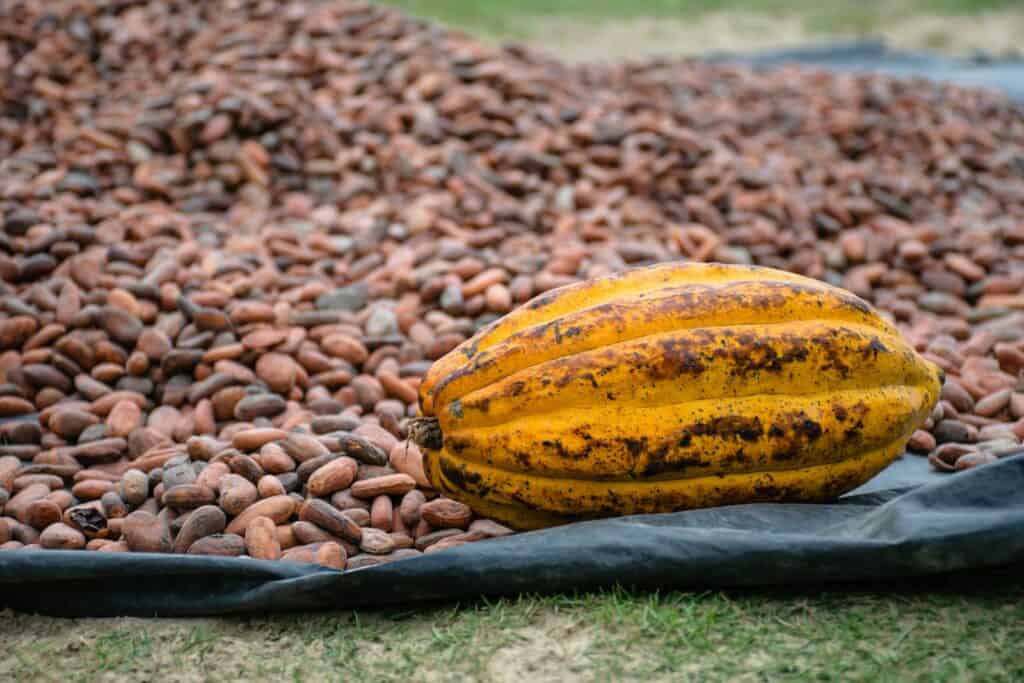
Diving into the world of chocolate, it’s fascinating to explore the rich history behind our favorite sweet treat. Here are some fun facts about chocolate to pique your interest and deepen your appreciation for this indulgent delight.
Chocolate’s journey began with the cacao bean. Cacao trees, or Theobroma cacao, are native to Central and South America. These trees produce cacao pods, which contain the precious cacao beans that eventually become the chocolate bars, milk chocolate, and dark chocolate we know and love today.
Believe it or not, the first chocolate treat was far from the sweet confections you might imagine. The word chocolate is actually derived from the Aztec word “xocoatl”, which referred to a bitter drink made from cacao beans. People in Central America and Mexico were enjoying this drink as far back as 1900 BC.
As chocolate spread to Europe, sugar and cocoa butter were added, creating a more palatable version of the once bitter drink. Innovations in the chocolate industry emerged later, with Joseph Fry creating the first solid chocolate bar in 1847 and Milton Hershey introducing the quintessential milk chocolate in 1900.
Interestingly, the hot chocolate we know today had a historical significance during the American Revolution. Benjamin Franklin sold chocolate in his print shop to cheer up and fortify troops.
Here are a few more surprising facts about chocolate:
- White chocolate is not considered chocolate in the strictest sense, as it contains mainly cocoa butter and no cocoa solids.
- The melting point of chocolate is just below the human body temperature, which is why it melts so easily in your mouth.
- Around 70% of the world’s cocoa beans come from West Africa, with the Ivory Coast being the largest producer.
- Chocolate can have health benefits – dark chocolate contains antioxidants, and studies have shown that consuming a small amount of dark chocolate daily may lower blood pressure.
Some more interesting tidbits about chocolate include:
- The famous chocolate chip cookie was created by accident, when Ruth Wakefield of the Toll House Inn added broken chocolate pieces to her cookie batter, expecting them to melt completely.
- German chocolate cake has nothing to do with Germany. It was named after Samuel German, an American chocolatier who created the special chocolate used in the recipe.
- During World War II, the U.S. Army commissioned a chocolate company to create a single-serving chocolate bar that wouldn’t melt during high heat exposure. This lead to the development of the military’s “ration bar”.
From its ancient beginnings to modern innovations, the world of chocolate has grown and evolved throughout history. Remember to savor the intricate history that accompanies every chocolate treat you enjoy!
Surprising Chocolate Health Benefits
Mention the phrase fun facts about chocolate, and your mind may immediately jump to the countless delicious desserts made from this delightful treat. Did you know, however, that there are some surprising health benefits included in that chocolate bar you’re indulging in? Let’s explore some of these incredible benefits!
While milk chocolate typically contains more sugar than its dark counterpart, both types have a base of cocoa beans that provide a treasure trove of health benefits. Rich in nutrients, mainly polyphenols, flavanols, and magnesium, these beans can have a positive impact on your heart, skin, and even mood.
Here’s how these health benefits break down:

- Heart health: Dark chocolate, specifically, contains a high percentage of cocoa solids, which have been associated with a reduced risk of heart disease. Studies suggest that consuming a moderate amount of dark chocolate may reduce blood pressure, improve blood flow, and lower the risk of arteriosclerosis.
- Skin protection: The flavanols in dark chocolate can help protect your skin against sun damage, by improving blood flow to the skin and increasing hydration levels.
- Mood enhancement: Chocolate is known to stimulate the production of endorphins, creating a natural mood-boosting effect. Moreover, it contains small amounts of phenylethylamine (PEA), a compound that triggers feelings of excitement and happiness.
An important note – these health benefits are mainly derived from dark chocolate with a cocoa content of 70% or more. Milk chocolate and white chocolate, which contain more sugar and cocoa butter, don’t offer the same level of benefits.
The bottom line is that chocolate, particularly high-quality dark chocolate, can offer some impressive health benefits. So, the next time you reach for a chocolate treat, remember that not only are you satisfying your taste buds, but you’re also doing your body a favor by indulging in these tasty bites.
Keep in mind, moderation is key! So enjoy your chocolate, but don’t overdo it. Now, go ahead, savor a piece of your favorite chocolate bar – guilt-free!
Quirky Facts About Chocolate Production
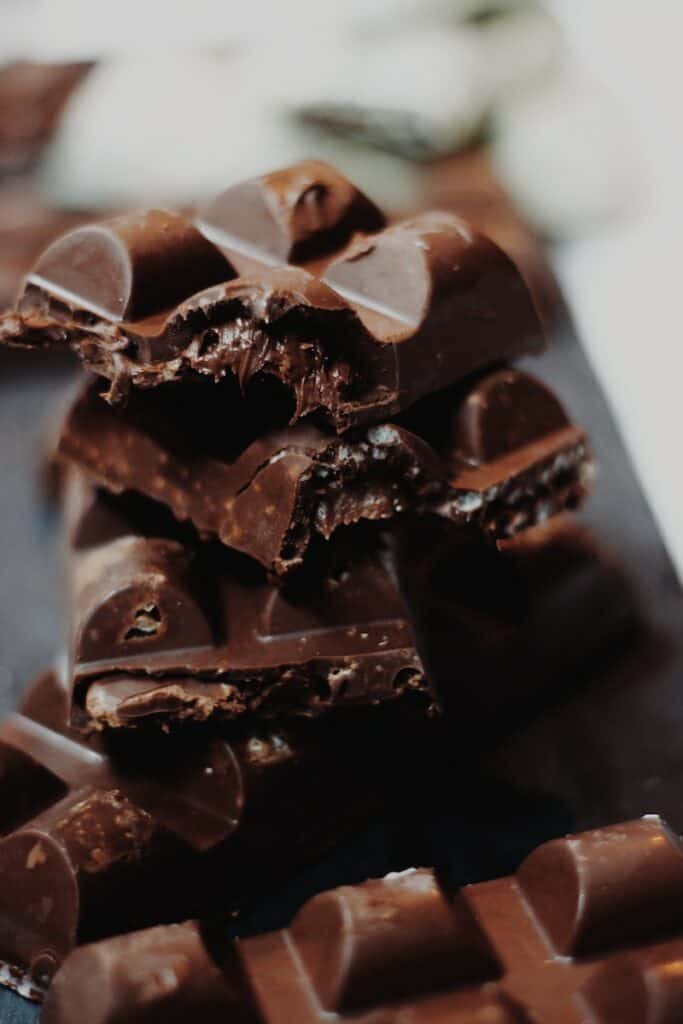
Among the many fun facts about chocolate, the way it’s produced uncovers some unique and interesting aspects. Let’s dive into a few noteworthy points about different types of chocolate and their production.
We’ll start with where chocolate originates: cacao beans. These beans grow on cacao trees found mainly in South and Central America, as well as West Africa. Ivory Coast is the largest producer of cacao beans in the world, accounting for about 40% of global production. Fun fact: cacao trees typically take about 5 years to mature and start producing these valuable beans.
Now, let’s talk about the different types of chocolate – milk chocolate, dark chocolate, and white chocolate. Curiously, white chocolate is not technically considered “chocolate” as it contains no cocoa solids. Instead, it’s made mainly of cocoa butter, sugar, and milk solids.
When it comes to dark chocolate, the higher percentage of cocoa solids and minimum sugar content is what sets it apart. It has a more bitter taste compared to milk chocolate because of this difference. As for milk chocolate, it combines cocoa solids, sugar, and milk to create a sweeter treat.
For those who enjoy a warm cup of hot cocoa or hot chocolate, there’s an interesting history behind these comforting beverages. Theobroma Cacao, the scientific name for the cacao tree, translates from Greek to “Food of the Gods.” In ancient times, chocolate was indeed consumed as a bitter drink made from cacao beans.
Another fascinating fact is that the melting point for chocolate is slightly below human body temperature. Thanks to this unique feature, chocolate melts easily in your mouth. Is there any wonder why it’s such a popular treat?
Here are a few more quirky and fascinating facts about chocolate:
- The first documented chocolate chip cookie came to life at the Toll House Inn in 1937, thanks to Ruth Wakefield. She added chocolate chips to her cookie batter, and a classic dessert was born!
- German chocolate cake has nothing to do with Germany – it’s named after Samuel German, who developed a sweet baking chocolate in the 1800s.
- Benjamin Franklin sold chocolate in his print shop.
Considering these interesting chocolate facts, it’s evident that chocolate has an incredible journey from cacao bean to a delightful chocolate treat for us to enjoy.
Chocolate in Popular Culture
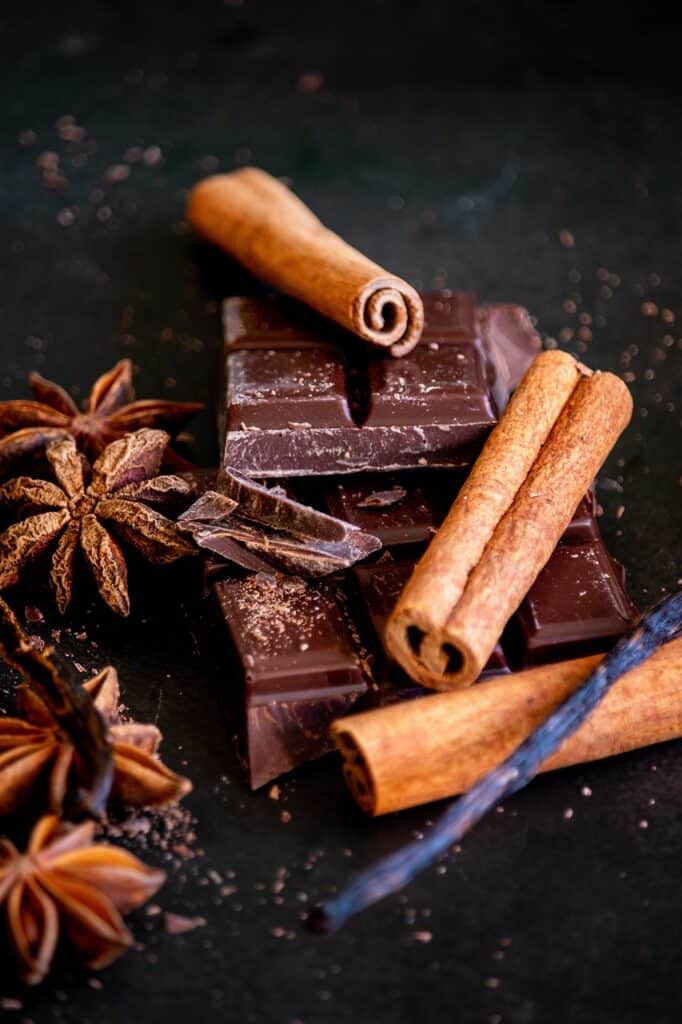
Chocolate has long been a favorite sweet treat, and over the years, it has worked its way into various aspects of popular culture. For instance, did you know the word “chocolate” is derived from the Aztec word “xocoatl,” which refers to a bitter drink made from cacao beans native to Central and South America? Considering the fun facts about chocolate, it’s easy to understand why it’s so beloved.
In what could be seen as an early celebrity endorsement, founding father Benjamin Franklin sold chocolate at his printing shop in Philadelphia. Dating back to World War II, the ration bar was a one-pound, high-energy chocolate bar given to soldiers as a portable and non-perishable food source. When it comes to movies and TV shows, the beloved chocolate factory from Roald Dahl’s children’s book, famously adapted into a film, demonstrates the magical appeal of this wonderful treat.
There are many different types of chocolate available, including dark chocolate which has a higher percentage of cocoa solids, milk chocolate made with milk and sugar, and white chocolate which contains mainly cocoa butter but no cocoa solids. Chocolate has been used creatively in countless recipes too. Some popular examples include:
- German Chocolate Cake: Despite its name, this dessert was named after the man Samuel German and not for the country. It comprises layers of cake made from cocoa powder and sweet chocolate frosting.
- Chocolate Chip Cookie: Invented by Ruth Wakefield at the Toll House Inn, the tasty cookie was created by accident when chunks of chocolate were added to cookie batter, resulting in a delicious, unexpected sweet treat.
- Hot Chocolate: First created by the Aztecs, today, this sweet beverage is made combining cocoa powder or chocolate liquor and hot milk or water, sometimes topped with whipped cream.
Interestingly, chocolate production is centered in West Africa, with the Ivory Coast being the largest global producer. In terms of consumption, Switzerland ranks at the top, with citizens consuming an average of 19.4 pounds per capita annually. The United States falls behind at 9.5 pounds per capita.
When it comes to health, dark chocolate in moderation has been proven to have a range of benefits, including lowering the risk of heart disease and improving brain function. The antioxidants found in chocolate, such as flavonoids, are known to provide these health benefits.
Finally, from a scientific perspective, chocolate has some unique properties. Its melting point is just below the average human body temperature (around 93°F or 34°C), allowing it to melt smoothly in your mouth. The rich and distinct aroma of chocolate, derived from more than 600 volatile compounds, is known to stimulate theta brain waves, promoting relaxation and stress relief.
There you have it – a brief but fascinating exploration of chocolate in popular culture. Discovering these interesting chocolate facts makes the experience of enjoying this delicious treat even more delightful.
World’s Most Expensive Chocolates
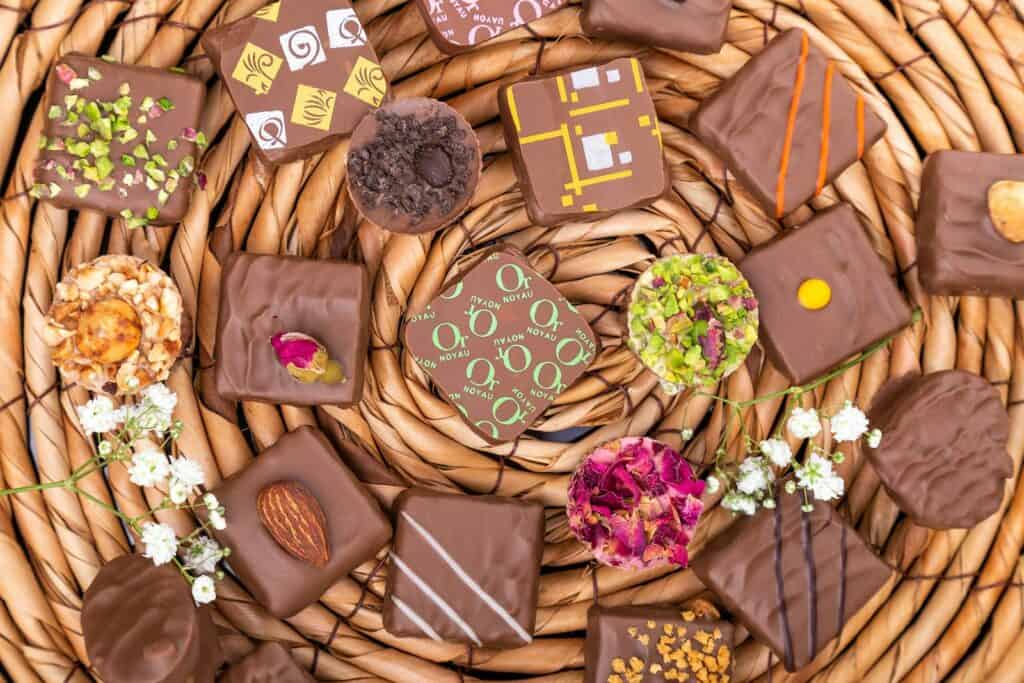
If you’re fascinated by fun facts about chocolate, you’ll be thrilled to learn about the world’s most expensive chocolates. These indulgent treats take cocoa beans, dark chocolate, and milk chocolate to luxurious new heights. Here are some impressive examples of these costly confections:
- To’ak Chocolate: Created using rare Nacional cacao beans from Ecuador, a single 50g bar of To’ak chocolate fetches a hefty price – around $385 per bar. These cacao beans are found on only a few cacao trees, making this chocolate an ultra-exclusive treat.
- Fritz Knipschildt’s Chocopologie: This chocolate truffle, made by renowned Danish chocolatier Fritz Knipschildt, sells for an astounding $2,600 per pound. The truffle contains a blend of 70% Valrhona dark chocolate, rich ganache, and rare French Perigord truffle, making it a truly decadent delight.
These lavish chocolates often use exquisite cocoa beans from cacao trees found in remote locations and employ unique production methods. Additionally, the extravagant packaging of these pricey chocolates adds to their overall allure.
Interestingly, various chocolate types like dark chocolate, milk chocolate, and white chocolate differ in price points. For example, white chocolate mainly contains cocoa butter, sugar, and milk solids, while dark chocolate boasts a higher cocoa percentage. This variation affects both the taste and the cost of these types of chocolate.
Chocolate aficionados are always eager to explore new and exciting chocolate treats, which makes these luxurious offerings all the more enticing. So the next time you enjoy a simple chocolate bar, just remember that there’s a whole world of high-end, gourmet chocolate delights awaiting you.
Final Thoughts: A Tasty Treat with Fascinating Facts
Getting to know the fun facts about chocolate has probably made you appreciate this sweet treat even more. From the origins of cocoa beans to the many varieties of chocolate available today, there’s no denying that chocolate has a rich history and diverse production process.
Different types of chocolate, such as milk chocolate, dark chocolate, and white chocolate, offer a delicious range of flavors and textures thanks to the varying amounts of cocoa butter, cocoa solids, and milk they contain.
Chocolate production starts with cacao beans harvested from cacao trees, which are mainly found in West Africa and South America. The beans undergo a series of processes, such as fermentation, roasting, and grinding, to produce chocolate liquor and cocoa butter. The first chocolate bar was created in 1847 by Joseph Fry, who combined cocoa butter with cocoa powder and sugar.
Interesting chocolate facts include Benjamin Franklin selling chocolate in his print shop and the invention of the chocolate chip cookie by Ruth Wakefield at the Toll House Inn, Massachusetts. It’s also worth noting that the melting point of chocolate is just below the human body temperature, which is why it melts so easily in your mouth.
Did you know that during World War II, the US government commissioned the creation of a ration bar that was a solid chocolate brick, designed to provide soldiers with sustenance and energy? Furthermore, the Ivory Coast in West Africa produces around 40% of the world’s cocoa beans, making it the largest supplier of cocoa.
Some of the health benefits associated with eating chocolate are its polyphenol content, which has antioxidant effects, and its potential to increase theta brain waves, which are linked to relaxation. However, moderation is key, as too much chocolate can lead to weight gain and health issues due to its high sugar and calorie content.
In conclusion, chocolate is a tasty treat with a fascinating history and production process. From its beginnings with the Aztecs and Mayans to its ubiquity in modern times, chocolate continues to delight taste buds and evoke feelings of comfort and happiness. Next time you enjoy a chocolate bar or a cup of hot cocoa, you’ll know a bit more about the journey your chocolate has taken to get to you.
